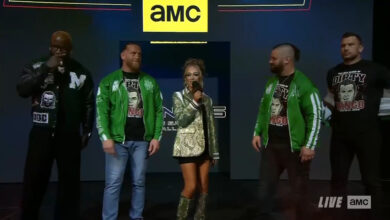Making A Finisher: Arn Anderson’s Spinebuster

A finishing move in the world of wrestling is crucial. Something that can make or break a pro wrestler, often the coolest looking moves don’t click, while something as goofy as “The People’s Elbow” becomes iconic. Each wrestler has a different method to their madness when landing on their signature, match ending match up. In this series, “Making A Finisher,” Fightful.com will go in depth with wrestlers as they explain their moves, discuss how they were developed, who took it the best, the worst, why they stopped doing some of them, and the psychology behind them.
***
Sometimes, a finishing move makes such an impact, it enters the lexicon of pro wrestling and is borrowed by almost everyone who steps into a ring. That’s the spinebuster. Specifically, Arn Anderson’s spinebuster.
Lifting an opponent by their legs, rotating, and slamming them down, Anderson’s Spinebuster is by far the most iconic version. That isn’t the case for a lot of moves, as wrestling and athleticism in general have evolved. Sometimes, the original sets an impossible tone to follow. But Anderson tells Fightful it wasn’t always the Spinebuster that finished off his opponents.
“Well, back in the early days, it was like the first actual move that was mine was the gourd buster. I kept seeing every night, and this was when I worked for Bill Watts now, so I’m in my infancy. This would be around 1982 and I’m wrestling Tim Horner and now I’ve been given the word that I’m gonna be leaving in two weeks. I’m going with Matt Borne to Atlanta and work for Ole [Anderson], I’m gonna have Paul Ellering, who I didn’t know who that was at the time, be my manager and all that. Tim said to me, “You need to get a finish.” So, we’re kicking stuff around and I kept seeing those beautiful, in those days if you stood a guy up on a vertical suplex and held him there it was a pretty thing, it was impressive. I thought, what if you just dropped a guy back down face first instead of on his back?,” Anderson said. “So he was willing to go that route with me, and we tried that a few times and that worked out. That became my first actual finish which didn’t get tons and tons of play because guys were, I think, a little nervous about it or that it might be dangerous, which it was not.”
The gourd buster was certainly a go-to for Anderson throughout his career, and was eventually renamed the brainbuster, the motivation for his team name with Tully Blanchard. However, it was an on-the-fly situation that led to Double A finding the move that would be tied to him for the rest of his life, and inspire hundreds of wrestlers along the way.
“One night I had a guy in a bear hug, and if you picture that you’re just about in spinebuster position when you’re in a bear hug. I thought, “Well, if I just shot this right hand underneath his thigh and took this left hand and went over his shoulder and just pivoted this one leg up and rotated, how would I land?” So, I don’t know how it just popped in there, but it just literally did pop in there, and so we tried a few. It was so smooth, so easy to get into there. Everybody that saw it, all the boys, were very kind about it. They went, “Hey, man. That’s innovative. That’s cool. That’s different. I’ve never seen that” Well, they’d never seen it ‘cause it hadn’t been done before,” Anderson said.
The spinebuster was born, and every wrestler who ever adopted the Anderson name, adopted the spinebuster as well. Magnum TA once told us a story of his favorite belly-to-belly suplex — one he had to stop midway through and go the other direction. Anderson never had the same experience with his finishing move.
“I don’t think I’m that lucky. Be honest with you, if it was gonna go south it was gonna go deep south. So, the answer would be no,” Anderson joked.
As effective as both the spinebuster and gourd buster were, Anderson needed more. The aforementioned techniques involved him lifting opponents up and dropping them, so he turned to another move that has since been picked up by everyone in wrestling — the DDT.
“Well, obviously, my style was not one that did a lot of power moves. I was suggested that stealing Jake [Roberts]’s DDT and hopefully putting some mustard on it. Which I tried to do, and switch it up a little bit from the way Jake did it, but still it was an out and out blatant theft. You know, whatever, I certainly owe him whatever he figures I owe him for stealing his move ‘cause it got a lot of reaction. I would say it was right up there with the spinebuster and bypassed the gourdbuster. But, that was my three, I would say, power moves. Everything else I tried to do was wrestling and rough wrestling, but yet smooth and thoughtful wrestling. I tried to take that last piece, whatever the exchange was between myself and an opponent, that last piece be something that you wouldn’t expect or the young lady sitting there wouldn’t expect or the five kids sitting next to them wouldn’t expect. So that they couldn’t predict the sequence of events which means that I tripped them up on the last piece and it was fun to watch to them. Does that make sense?” I was just gonna say not having all the talent to do all the high flying stuff and the high impact stuff that makes guys gas, that was kind of my trademark, to make my matches different. Then what I could do properly and things that made sense.”
In previous interviews with Arn, he mentioned CW Anderson asking him for permission to use the Anderson name. Since he innovated the spinebuster, it’s evolved into common territory in pro wrestling and hasn’t been a consistent finishing move fo years. However, it’s still associated with him, and used broadly across the world.
“Well, you know, of all people to ask me, Hunter actually had the respect me to ask me when I got there, “Do you mind if I start using your spinebuster?” He could have just done it, he didn’t need to ask, obviously. But, he does a good one,” said Arn.
Triple H is far from the only person doing spinebusters, and even good ones. Anderson has taken notice from the people who do it, to how they pull it off.
“I’m a huge Bobby Roode fan. He does a very good one. [Karl] Anderson, that’s currently with [Luke] Gallows, does a good one. Actually I’ve seen Rhyno do a good one. I think mine is a little bit different and it’s just because at the top, at the peak, it’s the left leg that comes up and does the pivot that makes mine a little different. Even if it’s a little slower, it picks up speed once the pivot happens, and that’s what separates mine from everybody else’s. Most guys have just a good whip. They’re all good, big, strong guys that’s got a good whip to it and it’s like one continual motion. Mine’s a little bit different and you don’t really realize what you’re gonna have until the landing goes down,” Anderson closed.
Past editions!
Adam “Hangman” Page’s Dead Eye
Damien Priest’s South Of Heaven Chokeslam
Stevie Ray’s Slapjack, Harlem Heat’s Harlem Hangover
“Switchblade” Jay White’s Blade Runner
Christopher Daniels’ Angel’s Wings
Magnum TA’s Belly-to-Belly Suplex
Darren Young’s Crossface Chickenwing
Kevin Owens’ Stunner and Steenalizer




